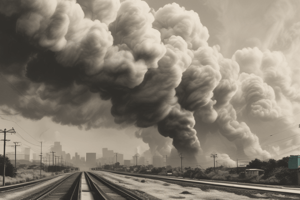Podcast
Questions and Answers
What type of contaminants are listed in Ontario Reg. 170/03?
What type of contaminants are listed in Ontario Reg. 170/03?
- Radioactive contaminants
- Both organic and inorganic contaminants (correct)
- Only organic contaminants
- Only inorganic contaminants
Why are drinking systems close to nuclear facilities required to test for radionuclides?
Why are drinking systems close to nuclear facilities required to test for radionuclides?
- To measure the level of organic contaminants
- To monitor algal toxins
- To detect the presence of pathogens
- Due to the proximity to potential radiological contaminants (correct)
What is the primary source of viruses like Hepatitis A in water?
What is the primary source of viruses like Hepatitis A in water?
- Chemical contaminants
- Radionuclides
- Algal blooms
- Sewage contamination (correct)
Why are pathogenic E.coli considered indicator organisms in water monitoring?
Why are pathogenic E.coli considered indicator organisms in water monitoring?
What is the significance of Cryptosporidum parvum and Giardia lablia in drinking water?
What is the significance of Cryptosporidum parvum and Giardia lablia in drinking water?
Why is chlorine typically used in water treatment processes?
Why is chlorine typically used in water treatment processes?
What is the purpose of coagulation in water treatment plants?
What is the purpose of coagulation in water treatment plants?
Why are Zebra and Quagga mussels a concern in Ontario?
Why are Zebra and Quagga mussels a concern in Ontario?
What is the impact of high BOD due to lots of sewage in water bodies?
What is the impact of high BOD due to lots of sewage in water bodies?
Which process in water treatment involves the removal of suspended solids by gravity settling?
Which process in water treatment involves the removal of suspended solids by gravity settling?
In a eutrophic lake, what is the characteristic of the water?
In a eutrophic lake, what is the characteristic of the water?
Why is physical disinfection like UV not acceptable for secondary disinfection in water treatment?
Why is physical disinfection like UV not acceptable for secondary disinfection in water treatment?
What can be a source of inorganic suspended solids in water bodies?
What can be a source of inorganic suspended solids in water bodies?
Which of the following is NOT a type of chemical disinfectant used in water treatment?
Which of the following is NOT a type of chemical disinfectant used in water treatment?
What is the main impact of acid deposition from acid rain on water bodies?
What is the main impact of acid deposition from acid rain on water bodies?
What is the main reason chlorine gas is often used at larger water treatment facilities?
What is the main reason chlorine gas is often used at larger water treatment facilities?
What is the primary reason for the formation of dead zones in bodies of water?
What is the primary reason for the formation of dead zones in bodies of water?
What is the consequence of the enrichment of a body of water leading to eutrophication?
What is the consequence of the enrichment of a body of water leading to eutrophication?
What distinguishes primary emissions of particulate matter (PM) from secondary emissions?
What distinguishes primary emissions of particulate matter (PM) from secondary emissions?
Why is lead considered a critical air pollutant?
Why is lead considered a critical air pollutant?
What is the main characteristic of volatile organic compounds (VOCs) in terms of their ability to vaporize?
What is the main characteristic of volatile organic compounds (VOCs) in terms of their ability to vaporize?
What role do trees play in emitting volatile organic compounds (VOCs) into the atmosphere?
What role do trees play in emitting volatile organic compounds (VOCs) into the atmosphere?
How can hazardous air pollutants such as benzene contribute to air pollution?
How can hazardous air pollutants such as benzene contribute to air pollution?
Why are non-methane volatile organic compounds (NMVOC) considered significant in terms of air pollution?
Why are non-methane volatile organic compounds (NMVOC) considered significant in terms of air pollution?
What is one method to reduce the volume of waste according to the text?
What is one method to reduce the volume of waste according to the text?
How can toxicity be reduced in printing according to the text?
How can toxicity be reduced in printing according to the text?
What is a common material used in composting as per the text?
What is a common material used in composting as per the text?
Which method is suggested for reducing lead and mercury in products?
Which method is suggested for reducing lead and mercury in products?
What is an example of waste prevention mentioned in the text?
What is an example of waste prevention mentioned in the text?
What is a suggested way to deal with untouched food according to the text?
What is a suggested way to deal with untouched food according to the text?
Flashcards are hidden until you start studying
Study Notes
Water Contaminants
- Chemical contaminants pose health risks and are regulated by Ontario Reg. 170/03, which lists parameters to be monitored, including both organic and inorganic substances.
- Radiological contaminants include naturally occurring elements and products/by-products of nuclear technologies, and drinking systems near nuclear facilities are required to test for radionuclides.
- Microbiological contaminants include pathogens such as viruses, protozoa, and bacteria, as well as algal toxins, which are important due to regulations and public health concerns.
Microbiological Contaminants
- Viruses are small microorganisms capable of reproduction only within living cells, examples include Hepatitis A, norovirus, and Rotavirus.
- Viruses are primarily from sewage contamination and can be inactivated with chlorine, but are not measured directly in drinking water.
- Bacteria are microorganisms, usually one cell, and not all bacteria are pathogens; pathogenic bacteria are used as indicator organisms.
- Protozoa are single-celled microorganisms that lack a cell wall, with two major concerns in drinking water being Cryptosporidum parvum and Giardia lambia.
Waste Reduction and Management
- Source reduction and reuse is waste prevention, including concentrated detergent, light-weight containers, and photocopying both sides of paper.
- Reducing toxicity involves using organic molecules instead of hazardous metals, such as soybean and organic inks in printing, and organic molecules in packing and plastics.
- Food waste can be reduced through composting, and untouched food can be delivered to social services.
Water Treatment
- Conventional surface water treatment plants include:
- Screen & Intake
- Coagulation
- Flocculation
- Clarification
- Filters
- Post Chlorination
- Clearwell
- Distribution System
- Coagulation involves rapid dispersion of coagulant in water to destabilize suspended particles and form precipitates.
- Flocculation involves gentle agitation of water to promote contact between particles, increasing settling rate or filterability.
- Sedimentation (clarification) removes suspended solids by gravity settling.
Disinfection and Inactivation
- Inactivation processes depend on raw water characteristics, and must balance the need to inactivate pathogens while minimizing disinfection-by-products.
- Chemical disinfectants include chlorine, chlorine dioxide, chloramines, and ozone.
- Physical disinfectants include UV, filtration, and heat.
Chlorination
- Chlorine is a greenish yellow gas, 2.5 times heavier than air, and is supplied in cylinders or tank cars.
- Chlorine demand is the amount of chlorine used up, and residual is the chlorine left in the water after demand is met.
- Combined and free residuals make up the total residual, and the type of residual depends on pH, temperature, and ammonia left in water.
Air Pollutants
- Particulate matter (PM) comes from both natural and human sources, including volcanoes, dust, and forest fires.
- Lead is a critical air pollutant, doesn't degrade, and is a legacy contaminant from sources like leaded paint, lead in drinking water, and leaded gasoline.
- Volatile organic compounds (VOCs) are organic compounds that easily vaporize, and come from sources like gaseous hydrocarbons, solvents, and trees.
- Hazardous air pollutants include benzene, which is a suspected carcinogen and contributes to sick building syndrome.
Studying That Suits You
Use AI to generate personalized quizzes and flashcards to suit your learning preferences.





